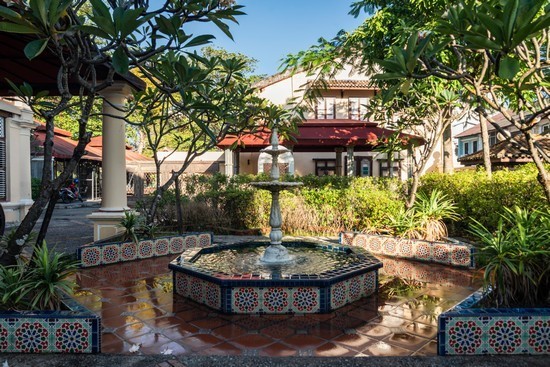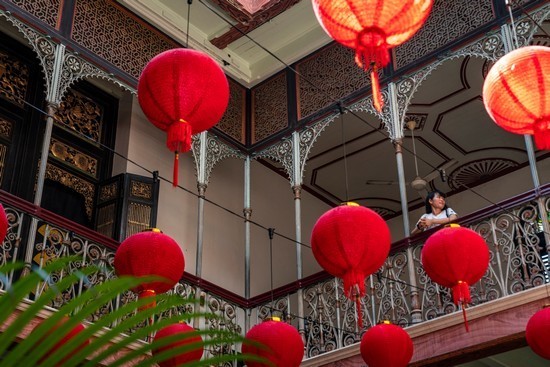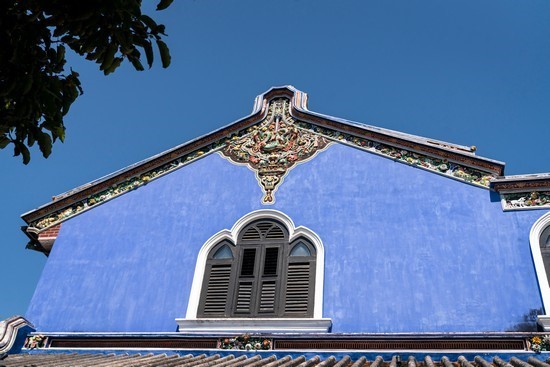“Try this way,” says Zainal Abidin, an affable
manager at the Prestige in George Town, Malaysia, cocking his head to one side.
Zainal is showing me around the hotel, which is named after the 2006 Christopher
Nolan film about two rival magicians. I am supposed to see an illusion in which
the corridor entrance transforms into a mirror, but it is not coming.
اضافة اعلان
“Or this way,” he says, bending his head to the left, then
back again. I follow suit — we must look like a couple of nodding dashboard
dogs — and abruptly the mirror appears. I take a step back.
 A courtyard at the
Jawi Peranakan Mansion, a hotel that mixes British colonial design with Indian
Muslim furnishings and decorations, in George Town, Malaysia.
A courtyard at the
Jawi Peranakan Mansion, a hotel that mixes British colonial design with Indian
Muslim furnishings and decorations, in George Town, Malaysia.
Zainal laughs, and I venture that this effect must be
confusing for guests returning late from one of George Town’s many bars. But
Zainal shakes his head: “Guests love it. The corridors are actually very
popular for Instagram shoots,” he says.
Most travelers know Malaysia for the beaches of Langkawi,
the iconic twin towers of Kuala Lumpur or the rainforests of Borneo. But the
colonial port city of George Town on the island of Penang, just off the Malay
Peninsula’s west coast, has a magic all its own. The core of the city — about
2.5 square kilometers of twisting alleys lined with two- and three-story
rowhouses that double as storefronts, known locally as shophouses — is a UNESCO
World Heritage site.
The listing describes George Town as “a unique architectural
and cultural townscape without parallel anywhere in East and Southeast Asia”, a
product of 500 years of trade and exchange between East and West. The island
was annexed by the British in 1786 and flourished as a trading entrepôt, with
Chinese and Indian immigrants mixing with the local Malay population to produce
a vibrant community in which English was (and still is) the lingua franca. The
city was eclipsed commercially by ports like Singapore many decades ago, but
Penangites, as they call themselves, remain an inventive, multicultural
community and are, in general, fiercely proud of their city.
This is no movie set: The neighbor of the hidden door that leads to a nightclub might be a garage resounding with the clang of tools being dropped and car bodies being hammered. For all its hidden charms, George Town is still noisily alive.
For visitors, all this leads to the serendipitous pleasure
of wandering the warren of narrow lanes looking to stumble across another
wonderfully photogenic facade painted in a mixture of delicate pastels with red
or black louvered wooden doors and elaborate carved gold inlays.
There is also the possibility that one of those doors will
lead to the perfect cup of coffee. Or a plate of fried noodles. Or a one-star
Michelin restaurant serving Nyonya cuisine, a fusion of Chinese, Malay, and
Indonesian cooking that the Michelin Guide calls “an exhilarating combination of
all things tangy, spicy, herbal, and aromatic”.
 A balcony overlooking
the charming courtyard at the Cheong Fatt Tze Mansion in George Town, Malaysia.
A balcony overlooking
the charming courtyard at the Cheong Fatt Tze Mansion in George Town, Malaysia.
Some of the shophouses are perfectly restored plaster
cornices gleaming with fresh pink, baby blue, or buttercup yellow paint. But
this is no movie set: The neighbor of the hidden door that leads to a nightclub
might be a garage resounding with the clang of tools being dropped and car
bodies being hammered. For all its hidden charms, George Town is still noisily
alive.
Restored mansions and modern charmBack at the Prestige, the tour is over and I am outside
looking at the gleaming white stuccoed walls, black metal balcony railings, and
graceful colonnades that flank the grand entrance. It is no coincidence that
the design echoes the Victorian features of the original buildings around it.
Although the Prestige was constructed from scratch on an empty lot, the
exterior design of the hotel had to blend into the city’s existing buildings to
comply with UNESCO’s strict rules.
Interiors are another matter, though. Apart from magical
touches such as the mirror illusion and a reception desk and beds that look as
if they are floating, the Prestige — like most newer hotels in George Town —
opted for a sleek modern look inside.
For those visitors who want their historical authenticity to extend more than skin-deep, George Town offers a range of boutique establishments in which the owners have gone to painstaking lengths to recreate the interiors as they were in the city’s boom
For those visitors who want their historical authenticity to
extend more than skin-deep, George Town offers a range of boutique
establishments in which the owners have gone to painstaking lengths to recreate
the interiors as they were in the city’s boom decades during the second half of
the 19th century.
The granddaddy of restored heritage hotels in George Town is
the Cheong Fatt Tze Mansion, named for the wealthy merchant who built it at the
end of the 19th century. The building, also known as the Blue Mansion for the
dominant color scheme, charms visitors with its shaded courtyards, gold-adorned
carved wooden doors, and cast-iron columns imported from Scotland. It has 18
rooms, but also hosts daily tours for those staying elsewhere. It is also where
the climactic mahjong scene in the movie “Crazy Rich Asians” was filmed.
Just down Leith Street is the newer Edison Hotel, also a
former tycoon’s residence. While the Blue Mansion is all nooks, shadows and
azure shades, the Edison’s restorers went for a white and pale green color
scheme and a more airy vibe that emphasizes delicate, cast-iron lacework
railings and courtyards that let in the sun.
 The Cheong Fatt Tze
Mansion, a prime example of the city’s restored heritage hotels, in George
Town, Malaysia.
The Cheong Fatt Tze
Mansion, a prime example of the city’s restored heritage hotels, in George
Town, Malaysia.
As with many boutique hotels, the owners concentrated most
of their efforts on bringing the buildings themselves back into shape,
preferring clean modern lines and fittings for the furniture and decoration.
But for Chris Ong, a former investment banker who runs four boutique heritage
hotels in the city, the aim was different: He wanted to restore everything in
the houses to exactly the way they were in their heydays a century ago, right down
to the curtains, furniture, and chandeliers.
Ong first returned to George Town, his hometown, to be with
his ailing mother after spending decades abroad. His first project was
restoring the family home, despite his mother’s adamant refusal to live in it,
remodeled or not. She preferred a modern apartment.
He is a fifth-generation Peranakan, an ethnic group whose
history goes back 600 years, when male immigrants from China married local
Malay women. Their multiracial culture flourished in Penang and other trading
ports in the region, including Malacca, Medan, and Singapore. Peranakan culture
— also known as Nyonya or Baba — is particularly famous in two areas: food and
design.
One you have eaten your fill, digest by wandering the city’s narrow alleys, where you are likely to stumble across an intriguing cafe or gallery.
The details stand out at Ong’s flagship hotel, Seven
Terraces. Built around an airy courtyard like other heritage houses in George
Town, Seven Terraces has only 18 rooms, but each one is a showcase of Peranakan
design, featuring blackwood and mother-of-pearl-inlaid furniture, elaborately
carved four-poster beds, embroidered footstools, and red and gold antique
cabinets. Items from Ong’s personal collection, including richly embroidered
Peranakan clothing and porcelain ware, also adorn the rooms.
Follow the scent of tamarind and nutmegHappily for visitors to George Town, the distinctive flavors
of Peranakan cuisine have been just as lovingly preserved as the architecture.
Without question, the city’s most famous Peranakan
restaurant is Auntie Gaik Lean’s Old School Eatery, which was awarded a
Michelin star in late 2022. Occupying a shophouse on Bishop Street, Auntie Gaik
Lean’s is definitely not a fine-dining establishment. It focuses squarely on
homey Nyonya dishes, most of which feature the characteristic tangy-sour taste
of tamarind. There’s also a nutmeg juice on the menu for those who cannot get
enough of the restaurant’s spice-heavy Nyonya kick.
Penangites are famous for their all-consuming love of
eating, an obsession that naturally generates equally strong opinions. That
means every Penangite has a favorite Peranakan restaurant, or several of them.
Ong, for example, cites Baba Phang, Ceki, and Winn’s Cafe as his go-to spots
for traditional Nyonya fare.
For more adventurous but still very much local food, Gen,
which describes its dishes as innovative Malaysian, shines. The restaurant
offers only a fixed-price menu of 450 ringgit (about $100) a head for nine
courses and four desserts. Dishes feature local ingredients prominently,
ranging from citrusy bunga kantan, or ginger flower, to a spice called buah
kulim, a golf-ball-size fruit redolent of garlic. There is also chocolate made
from homegrown cacao pods and even “tropical caviar” from locally raised
sturgeon (really).
One you have eaten your fill, digest by wandering the city’s
narrow alleys, where you are likely to stumble across an intriguing cafe or
gallery. Bars have also flourished in recent years, though some are hard to
find through mere serendipity. Having adopted the speakeasy model, they often
do not have signs or even street numbers. Happily, Google Maps has no qualms
about giving away their locations.
In the case of Archipelago, for example, an internet search
even provides a picture of the unassuming blue doorway that leads to this
delightful hideaway on Armenian Street. (Ignore what appear to be a couple of padlocks
securing the door: They are just for show.)
Another bar, the Mandarin on Irving Street, is similarly
tucked away, though it does actually have a street number on its facade. Lim
Yin Wei, its self-taught mixologist and owner, prefers an intuitive approach to
relying on the classics. New arrivals to the lounge are gently queried on what
kind of a day they have had, then promised a suitable restorative. On our
visit, my companion confided that she had had a tough day. After a short
interlude, the smiling barman reappeared with a greenish, citrusy concoction
decorated with cucumber, thyme, and edible flowers.
My companion deemed it “magical”. Just like George Town.
Read more Travel
Jordan News







